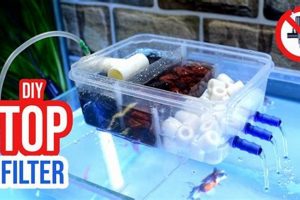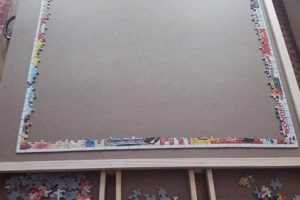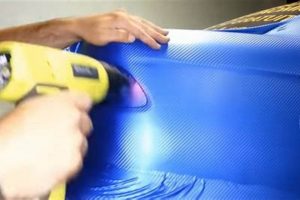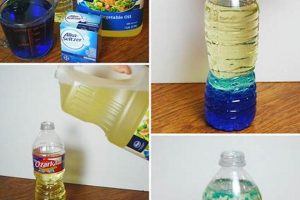A constructed enclosure, often translucent, designed to provide even and diffused illumination for various purposes, such as photography, tracing, or product display, is the subject of this examination. These devices allow for controlled lighting conditions, minimizing harsh shadows and enhancing visibility. For example, a photographer might employ such a tool to achieve consistent and professional-looking images of small objects.
The significance of such an illumination apparatus lies in its capacity to improve visual clarity and consistency. Historically, similar contrivances have been employed in art studios and drafting rooms to aid in detailed work. Modern applications extend to diverse fields, including e-commerce, where product presentation is paramount, and scientific research, where precise observation is critical. The consistent lighting environment afforded by these constructions allows for more accurate representations and reduces the variability caused by ambient light.
The subsequent sections will delve into the materials required for its construction, explore different design variations suitable for specific needs, and provide step-by-step instructions for building a functional and cost-effective unit. Considerations for selecting the appropriate light source and diffusing materials will also be addressed.
Construction Considerations
Effective creation necessitates careful planning and execution. The following guidelines will aid in optimizing the functionality and longevity of the finished product.
Tip 1: Material Selection. Prioritize the selection of rigid, opaque materials for the enclosure’s frame. Dense cardboard, plywood, or plastic sheeting provide structural integrity and prevent light leakage, ensuring controlled illumination within the interior.
Tip 2: Diffusion Panel Optimization. Employ multiple layers of diffusion material, such as tracing paper or thin white fabric, to achieve a smooth, even light distribution. Experiment with varying distances between the light source and the diffusion panels to minimize hotspots and shadows.
Tip 3: Light Source Selection. Opt for continuous light sources, such as LED panels or fluorescent tubes, over incandescent bulbs. LEDs offer superior energy efficiency, lower heat emission, and consistent color temperature, crucial for accurate visual representation.
Tip 4: Internal Reflectivity Enhancement. Line the interior surfaces with reflective material, such as white paint or aluminum foil. This maximizes light utilization and reduces shadows within the enclosure.
Tip 5: Dimensional Proportionality. Adjust the dimensions of the structure to suit the intended application. A larger enclosure accommodates larger objects, while a smaller unit is suitable for close-up photography of smaller items.
Tip 6: Ventilation Management. Implement ventilation holes or a small fan to dissipate heat generated by the light source. Overheating can damage components and alter the light’s color temperature.
Tip 7: Modular Design. Consider a modular design, allowing for disassembly and storage when not in use. This is particularly beneficial for individuals with limited space.
Adherence to these guidelines will result in a durable, effective, and versatile illumination tool. Its proper construction is paramount for achieving consistent and reliable results in various applications.
The final section will cover advanced features and modifications to further customize the created illumination device to specific requirements.
1. Illumination Intensity
Illumination intensity, measured in lux or lumens, represents a critical determinant of effectiveness. Its proper management within the confines of a constructed lighting apparatus directly influences the quality of captured images, the accuracy of traced outlines, and the overall utility of the device.
- Light Source Selection and Intensity Control
The choice of light source significantly affects the achievable intensity. LED panels, fluorescent tubes, and incandescent bulbs offer varying levels of brightness. Dimming capabilities, whether through integrated controls or external devices, allow for precise adjustment to suit specific tasks. For example, macro photography often requires high illumination intensity to capture fine details, while tracing delicate drawings might necessitate a lower, more diffused light level.
- Distance and Diffusion Effects
The distance between the light source and the subject, coupled with the type and number of diffusion layers, modulates the perceived illumination intensity. Increasing the distance reduces the intensity, while adding diffusion layers scatters the light, creating a softer, less intense effect. This principle is employed to minimize harsh shadows and prevent overexposure in photographic applications. A greater distance or more diffusion layers are applicable for reflective subjects.
- Surface Reflectivity and Light Absorption
The reflectivity of the internal surfaces within the enclosure influences the overall illumination intensity. Highly reflective surfaces, such as white paint or aluminum foil, maximize light utilization, leading to a brighter and more evenly lit interior. Conversely, dark or matte surfaces absorb light, reducing the intensity. Optimizing internal reflectivity is crucial for achieving uniform illumination and minimizing light wastage.
- Application-Specific Requirements
The required illumination intensity varies depending on the intended application. Product photography often demands high intensity to showcase details and textures, while tracing and drawing benefit from a lower, more diffused light that reduces eye strain. Understanding the specific requirements of each application is essential for selecting the appropriate light source and adjusting the intensity accordingly. This consideration ensures optimal results and user comfort.
The interplay of these factors dictates the final illumination intensity within the constructed illumination device. Careful consideration of light source selection, diffusion techniques, surface reflectivity, and application-specific requirements is necessary to achieve optimal performance. Insufficient illumination intensity compromises image quality and tracing accuracy, whereas excessive intensity can cause overexposure and eye fatigue. A well-calibrated illumination intensity is, therefore, paramount for realizing the full potential of a diy light box.
2. Diffusion Quality
Diffusion quality represents a critical attribute in the performance of a constructed illumination device, directly affecting the uniformity and softness of the emitted light. Proper diffusion mitigates harsh shadows and hotspots, enhancing the visual appeal and accuracy of images or tracings produ
ced with the aid of such an apparatus.
- Material Selection and Layering
The choice of diffusion materials, such as tracing paper, vellum, or specialized diffusion fabric, significantly influences the quality of light. Layering multiple sheets of diffusion material progressively softens the light, reducing specular highlights and creating a more even illumination pattern. The type and number of layers must be carefully calibrated to achieve the desired effect without unduly diminishing light intensity. Example: using too few layers results in clearly visible light source outlines, while excessive layering drastically reduces the overall brightness.
- Distance Between Light Source and Diffuser
Increasing the distance between the light source and the diffusion panel allows light rays to spread out more evenly before interacting with the diffuser. This spatial separation minimizes the impact of individual light source elements and contributes to a more homogenous diffusion pattern. Practical implication: a light source positioned too close to the diffuser generates pronounced hotspots, while a greater distance promotes even distribution.
- Surface Properties of the Diffuser
The texture and finish of the diffuser’s surface play a critical role in light scattering. Matte or frosted surfaces promote greater diffusion compared to glossy surfaces, which tend to transmit light more directly. Irregularities or textures on the diffuser surface further contribute to light scattering, but excessive roughness can reduce light transmission efficiency. A balance between diffusion and light transmission is necessary for optimal performance.
- Enclosure Geometry and Reflectivity
The shape and internal reflectivity of the enclosure contribute to diffusion quality. Curved or angled surfaces promote more even light distribution compared to flat surfaces. Highly reflective interior surfaces maximize light utilization and reduce shadows, enhancing the overall diffusion effect. Lining the interior with white or reflective material is crucial for achieving optimal diffusion uniformity. Example: A conical or parabolic internal shape helps to bounce light around and reduce hot spots.
Effective diffusion quality within a diy light box is a product of strategic material selection, thoughtful spacing of light sources and diffusers, optimized surface properties, and enclosure design. The interplay of these elements dictates the uniformity and softness of the emitted light. Careful management of these factors is crucial for realizing the full potential of the constructed lighting apparatus and achieving consistent, high-quality results across various applications.
3. Enclosure Rigidity
Enclosure rigidity, in the context of a constructed illumination device, directly influences its structural integrity, light containment efficacy, and long-term usability. Insufficient rigidity compromises the enclosure’s shape, potentially leading to light leakage, inconsistent illumination patterns, and premature failure. A robust enclosure maintains its form under stress, ensuring that the internal light environment remains stable and predictable. Consider, for example, a cardboard enclosure constructed with inadequate reinforcement. Over time, it may warp or collapse, altering the angle of internal reflections and disrupting the uniformity of light diffusion. The photographic results or tracing accuracy will then be compromised, rendering the device less effective.
The selection of construction materials directly impacts the achievable rigidity. Dense materials, such as plywood or thick plastic sheets, inherently provide greater structural support than lighter alternatives, such as thin cardboard or fabric. Furthermore, the method of assembly including the use of adhesives, fasteners, or reinforcing elements significantly contributes to the overall rigidity of the structure. A light box constructed with precisely cut components and securely bonded joints exhibits greater resistance to deformation and external forces. Conversely, loosely assembled structures are prone to instability and potential collapse. In applications requiring frequent transportation or heavy use, increased emphasis on rigidity becomes paramount to prevent damage and maintain operational functionality. For example, a portable light box used for on-site product photography requires a significantly more robust construction than a stationary unit used exclusively in a studio setting.
In summary, enclosure rigidity is not merely a cosmetic attribute but a fundamental requirement for a functional and durable diy light box. It directly affects the consistency of the light environment, the longevity of the device, and its suitability for various applications. Prioritizing the selection of rigid materials and employing robust construction techniques are essential for maximizing the effectiveness and lifespan of the constructed illumination apparatus. Failure to adequately address enclosure rigidity can result in suboptimal performance, increased maintenance costs, and ultimately, the premature obsolescence of the device.
4. Light Source
The selection of an appropriate light source is a paramount consideration in the design and construction of any illumination apparatus. The characteristics of the chosen emitter fundamentally dictate the quality, intensity, and spectral properties of the light provided, thus significantly influencing the ultimate utility of a diy light box.
- Type of Emitter
Various types of light emitters are suitable for utilization within such devices, including incandescent lamps, fluorescent tubes, and light-emitting diodes (LEDs). Incandescent lamps, while historically prevalent, are largely inefficient and produce substantial heat, rendering them less desirable. Fluorescent tubes offer improved efficiency and lower heat output but often exhibit a less desirable spectral distribution. LEDs represent the most modern and versatile option, providing high efficiency, low heat emission, and a broad range of color temperatures and intensities. The choice among these emitters should align with the specific application requirements and budgetary constraints.
- Color Temperature
The color temperature of the light source, measured in Kelvin (K), defines the perceived warmth or coolness of the emitted light. Lower color temperatures (e.g., 2700K) produce a warm, yellowish light, while higher color temperatures (e.g., 6500K) yield a cool, bluish light. The optimal color temperature depends on the intended use of the illumination apparatus. For tasks requiring accurate color representation, such as product photography, a daylight-balanced light source (around 5500K-6500K) is generally preferred. Conversely, for creating a warmer, more inviting ambiance, a lower color temperature may be more appropriate.
- Luminous Intensity and Control
Luminous intensity, typically measured in lumens, quantifies the total amount of light emitted by the source. The appropriate intensity depends on the size of the illumination apparatus and the nature of the illuminated subject. Furthermore, the ability to control the intensity, either through dimming capabilities or adjustable positioning of the emitter, offers significant flexibility. Dimming allows for fine-tuning the light level to suit varying tasks or subject characteri
stics. In product photography, for example, adjusting the intensity can prevent overexposure or underexposure, ensuring optimal image quality. - Energy Efficiency and Longevity
Energy efficiency and operational lifespan are crucial factors in selecting a light source. LEDs generally exhibit significantly greater energy efficiency and longer lifespans than incandescent or fluorescent alternatives. This translates to lower operating costs and reduced maintenance requirements. Over the long term, the initial investment in more efficient and durable emitters proves to be cost-effective. Furthermore, the environmental impact of the light source should be considered, with LEDs representing a more sustainable option due to their reduced energy consumption and longer lifespan.
The careful consideration of these light source characteristics is indispensable for achieving optimal performance in a diy light box. The selection must be tailored to the intended application, taking into account color temperature requirements, luminous intensity needs, and concerns regarding energy efficiency and longevity. A well-chosen light source is the cornerstone of an effective and versatile illumination apparatus.
5. Material Opacity
Material opacity, concerning a constructed illumination device, dictates the extent to which light is permitted to pass through the enclosure’s constituent components. This characteristic fundamentally influences light containment, image clarity, and overall functionality. Precise control over opacity is crucial for directing illumination and preventing extraneous light from contaminating the desired lighting environment.
- Enclosure Construction and Light Containment
The selection of materials with appropriate opacity is paramount for constructing the enclosure. Opaque materials such as wood, thick cardboard, or dark plastics prevent external light from entering and internal light from escaping, ensuring a controlled environment. Conversely, translucent materials, if used improperly, can compromise the integrity of the lighting setup. For instance, using a clear plastic container as the enclosure would render the device ineffective due to uncontrolled light transmission, severely hindering its intended purpose.
- Diffusion Panel Support Structures
While diffusion panels themselves are intended to transmit light, the supporting structures holding these panels in place must exhibit adequate opacity. Any light leakage around the edges or through the support framework can create unwanted highlights or shadows, diminishing the uniformity of illumination. Even small gaps or translucent joints can introduce distracting artifacts into photographs or tracings. Proper design and careful construction techniques are necessary to minimize these issues.
- Internal Reflective Surfaces
The opacity of materials used as internal reflective surfaces influences the efficiency of light distribution within the enclosure. While the reflective coating itself should be highly reflective, the underlying material must be sufficiently opaque to prevent light from being absorbed or transmitted through the enclosure walls. For example, using thin aluminum foil backed by translucent plastic could result in light loss and reduced overall brightness. Selecting a backing material with high opacity, such as black foam core, ensures maximum light reflection and efficient utilization of the light source.
- Controlling Backlight and Shadows
Strategic use of opaque materials can assist in controlling backlight and minimizing unwanted shadows. By carefully positioning opaque panels or masks within the enclosure, specific areas can be shielded from direct light, creating desired lighting effects. This technique is particularly useful in product photography for highlighting specific features or creating dramatic contrast. For instance, placing an opaque card behind a translucent object can prevent backlight from washing out the subject and create a clean, defined silhouette.
These considerations illustrate the critical role of material opacity in constructing a functional diy light box. The judicious selection and application of opaque materials are essential for establishing a controlled lighting environment, maximizing light utilization, and achieving consistent, high-quality results. Failure to adequately address opacity can compromise the integrity of the illumination, leading to subpar performance and undermining the intended benefits of the device.
6. Dimensional Accuracy
Dimensional accuracy, in the context of constructing an illumination device, refers to the precision with which the physical dimensions of the constituent parts conform to the intended design specifications. This factor directly impacts the structural integrity, light containment efficacy, and overall functional performance of the resulting diy light box. Deviations from specified dimensions can lead to misalignment of components, light leakage, and uneven illumination, thereby compromising the device’s intended purpose.
- Structural Integrity and Stability
Precise dimensional measurements are crucial for ensuring structural integrity and stability. Accurate cuts and consistent dimensions are essential for constructing a frame that can withstand the intended load and maintain its shape over time. For example, if the side panels of a rectangular enclosure are not cut to the correct dimensions, the resulting structure may be skewed or prone to collapse, rendering it unusable. Accurate dimensions also ensure proper alignment of components, preventing stress points and potential failures.
- Light Containment and Minimization of Light Leakage
Dimensional accuracy directly affects the effectiveness of light containment. Gaps or misalignments arising from inaccurate dimensions create pathways for light to escape, compromising the controlled illumination environment. Precise measurements and tight tolerances are necessary to ensure that all joints and seams are properly sealed, preventing unwanted light leakage. This is particularly critical in applications where precise lighting control is paramount, such as product photography or scientific imaging.
- Uniform Illumination and Light Distribution
Accurate dimensions are essential for achieving uniform illumination within the diy light box. The placement and alignment of light sources, diffusion panels, and reflective surfaces must adhere to the design specifications to ensure consistent light distribution across the illuminated area. Inaccurate dimensions can lead to uneven light patterns, hotspots, or shadows, compromising the quality of the images or tracings produced. Consistent dimensions are crucial for creating a predictable and controlled lighting environment.
- Ease of Assembly and Component Compatibility
Dimensional accuracy greatly facilitates the assembly process and ensures compatibility between different components. Precise cuts and consistent dimensions simplify the task of joining parts together and minimize the need for adjustments or modifications. Accurate measurements also guarantee that components, such as light sources, diffusion panels, and support structures, fit together seamlessly, creating a cohesive and functional unit. This reduces the
time and effort required for construction and ensures a more professional-looking finished product.
These facets demonstrate the inextricable link between dimensional accuracy and the successful creation of a diy light box. Neglecting precision in measurements and construction compromises not only the structural integrity but also the lighting performance and overall utility of the device. Therefore, meticulous attention to dimensional accuracy is paramount for achieving optimal results and realizing the full potential of this constructed illumination tool.
7. Assembly Stability
Assembly stability, within the context of constructing an illumination device, refers to the capacity of the assembled structure to maintain its form and integrity under anticipated use conditions. This attribute directly impacts the device’s durability, reliability, and overall safety. Inadequate assembly stability can lead to structural failure, light leakage, and potential hazards, thereby undermining the device’s effectiveness and usability.
- Joint Integrity and Fastener Selection
The integrity of the joints connecting the various components dictates overall stability. The selection of appropriate fasteners, adhesives, or joining techniques is crucial. Weak joints may fail under stress, causing the enclosure to deform or collapse. For example, a light box constructed with insufficient adhesive at the corners may separate over time, compromising its structural integrity and allowing external light to contaminate the internal illumination environment. The chosen joining method must be suitable for the materials being used and capable of withstanding anticipated loads and environmental conditions.
- Material Compatibility and Expansion/Contraction
Different materials exhibit varying degrees of thermal expansion and contraction. When dissimilar materials are joined together, differential expansion can induce stress on the joints, potentially leading to failure. For example, attaching a metal frame to a wooden panel without accounting for differences in thermal expansion can cause warping or separation over time. Careful consideration of material compatibility and appropriate joint design are essential to mitigate these risks. Utilizing flexible adhesives or mechanical fasteners that allow for some degree of movement can help accommodate differential expansion and prevent stress build-up.
- Load Distribution and Support Structures
The design of the support structure and the distribution of loads throughout the assembly significantly impact stability. Uneven load distribution can concentrate stress on specific areas, increasing the risk of failure. Reinforcing weak points and providing adequate support for heavy components, such as light sources, is crucial. For example, a large light box with a heavy LED panel mounted on the top may require additional bracing to prevent sagging or collapse. Proper load distribution ensures that stress is evenly distributed throughout the structure, enhancing overall stability and longevity.
- Vibration Resistance and Environmental Factors
The ability to withstand vibration and other environmental factors, such as humidity and temperature fluctuations, is essential for long-term stability. Exposure to vibration can loosen fasteners and weaken joints, while humidity and temperature changes can cause materials to warp or degrade. Selecting durable materials and employing robust assembly techniques are crucial for ensuring that the light box can withstand these challenges. For example, using corrosion-resistant fasteners and sealing joints with weather-resistant sealant can help protect the assembly from moisture damage. Implementing vibration-dampening measures, such as rubber feet or isolation mounts, can minimize the impact of external vibrations.
In conclusion, assembly stability represents a critical factor in determining the durability and reliability of a diy light box. Careful attention to joint integrity, material compatibility, load distribution, and environmental resistance is essential for creating a structure that can withstand the rigors of repeated use and maintain its functional performance over time. Neglecting these considerations can lead to premature failure, compromised lighting quality, and potential safety hazards. A well-assembled and stable light box provides a reliable and consistent illumination environment, enhancing its utility for various applications.
Frequently Asked Questions
This section addresses common inquiries concerning the construction and utilization of an illumination apparatus. The information provided aims to clarify practical considerations and dispel potential misconceptions.
Question 1: What constitutes an acceptable light source for optimal performance?
The selection of a light source is crucial. Light-emitting diodes (LEDs) are generally preferred due to their energy efficiency, low heat emission, and consistent color temperature. Fluorescent lamps represent a viable alternative, although their spectral characteristics may be less desirable for certain applications. Incandescent bulbs are typically discouraged due to their inefficiency and high heat output.
Question 2: How should diffusion materials be selected and implemented to achieve uniform illumination?
Diffusion materials, such as tracing paper or translucent fabric, should be selected based on their ability to scatter light evenly without significantly reducing its intensity. Multiple layers of diffusion material are often employed to minimize hotspots and create a softer, more uniform light distribution. The distance between the light source and the diffusion panel also influences the outcome.
Question 3: What materials are best suited for constructing a rigid and durable enclosure?
Rigidity and durability are essential for long-term use. Plywood, dense cardboard, or plastic sheets offer adequate structural support. The enclosure’s design should minimize stress points and prevent warping or collapse. Proper joint construction, using adhesives or fasteners, is crucial for maintaining structural integrity.
Question 4: How can light leakage be minimized to maintain a controlled illumination environment?
Light leakage undermines the controlled illumination environment. Opaque materials should be used for the enclosure walls and joints. Sealants or light-blocking tape can be applied to gaps or seams to prevent extraneous light from entering. Careful attention to detail during construction is paramount.
Question 5: What dimensional considerations are critical for achieving accurate and consistent results?
Dimensional accuracy is vital for ensuring proper alignment and light distribution. Precise cuts and measurements are essential for creating a symmetrical and well-proportioned enclosure. Variations in dimensions can lead to uneven illumination and structural instability. The internal dimensions should be tailored to the size of the objects being illuminated.
Question 6: How does ventilation impact the performance and longevity of the device?
Ventilation is necessary to dissipate heat generated by the light source. Overheating can damage components and alter the light’s color temperature. Ventilation holes or a small fan can be incorporated into the design to ensure adequate airflow. The placement of ventilation openings should prevent light leakage.
These questions rep
resent common concerns regarding diy light box construction. Careful consideration of these factors contributes to a more functional and reliable illumination device.
The next section will address potential modifications and advanced features for specific applications.
Conclusion
This exploration has comprehensively addressed the design, construction, and critical considerations for a diy light box. Key factors such as light source selection, diffusion quality, material opacity, dimensional accuracy, and assembly stability have been thoroughly examined. The interplay of these elements dictates the overall performance and suitability of the apparatus for various applications, ranging from product photography to detailed tracing.
The information presented serves as a foundation for informed decision-making in the creation of these specialized illumination devices. Adherence to the principles outlined ensures a functional, reliable, and cost-effective solution for controlled lighting needs. Further investigation into advanced techniques and modifications, tailored to specific requirements, will continue to expand the potential of this versatile tool.







